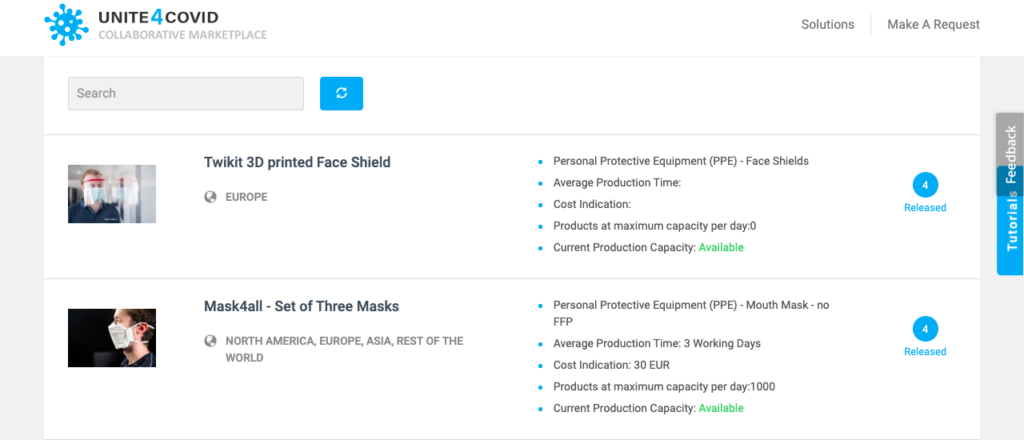Companies, organizations and individuals continue to attempt to lend support to the COVID-19 pandemic supply effort. We will be providing regular updates about these initiatives where necessary in an attempt to ensure that the 3D printing community is aware of what is being done, what can be done and what shouldn’t be done to provide coronavirus aid.
Dutch chemical company DSM has launched a platform for connecting healthcare providers and businesses for the supply of personal protection equipment (PPE) and other items. UNITE4COVID acts as a hub in which manufacturers and certifications labs can be linked to medical professionals in order to provide PPE and safety equipment.
Fortify is 3D printing tooling for injection molding meant to produce an adapter that converts a snorkel into a face mask. By making the tooling with its own 3D printing technology, the company believes that it could reduce the lead time for mold production by 75 percent, cutting a 14-day lead time to three days and potentially reducing costs from $2,000 to $300.
Origin has begun shipping its nasopharyngeal swabs, which are now FDA-registered, Class I, 510K medical products. Bulk orders of the swabs can be ordered on the company’s website.
A thirteen-year-old Tennessee student is using his own desktop 3D printer to produce ear savers, meant to reduce chafing caused by facial masks. Printing at a rate of eight ear savers in three-and-a-half hours, Sam Walker is running his printer 17 hours a day, giving them to local doctors, nurses, pharmacists and retirement home employees.
Also making ear savers is a collective of companies including Ultimaker, HP and other businesses, such as ImageNet Consulting, which has made over 10,000 such devices. While we have covered many of HP’s initiatives so far, Ultimaker’s involvement is made up of a two-part endeavor in which hospitals with pre-approved designs and material specifications are connected to 3D printing companies like 3D Hubs and ImageNet, a substantial U.S. reseller of IT technology and 3D printers, to produce the equipment.
Members of Amazon’s Prime Air mechanical design and hardware teams have joined a Washington State initiative that is producing face shields for healthcare workers. Based on feedback from medical professionals, the Amazon team claims to have improved the initiative’s existing face shield design, including material quality, so that they can be reusable and keep the shield in place more effectively. The new design also reduced sharp edges and pressure to the forehead, as well as improved print time. The Prime Air team subsequently made the U.S National Institutes of Health-approved design available for 3D printing and injection molding.
So far, Amazon has donated about 10,000 face shields and aims to deliver 20,000 more, using systems typically used to cut fiber materials for drone manufacturing to cut the face shield screens. Soon, the retail behemoth aims to mass produce face shields, suggesting it will be able to make hundreds of thousands over the next few weeks and have them available through the Amazon website. A recent blog post on the topic states:
“Because of the design innovations and the capabilities of our supply chain, we are confident we will be able to list them at a significantly lower price—almost a third of the cost—than all other reusable face shields currently available to frontline workers. We are looking to prioritize frontline workers and then eventually open up to all Amazon customers.”
During the pandemic, Amazon has faced harsh criticism from employees, including at Amazon warehouses and Whole Foods, who striking for better conditions as they continue to work amid the health crisis. While warehouse workers in multiple cities are demanding that Amazon shut down facilities where employees have been tested positive for COVID-19, CEO Jeff Bezos has grown his wealth by $25 billion since January 1, which the Institute for Policy Studies has described as “unprecedented in modern financial history.”
A leaked memo indicated that, after firing a worker who played a role in organizing a strike at a Staten Island distribution warehouse, company executives would discredit the worker and the larger movement to unionize Amazon workers. The employee was described as “not smart or articulate.”
According to VICE, who received the leaked documents, the company has attempted to cover its labor record in the midst of the pandemic with public relations efforts. Included in those efforts is the possibility of making free masks, with Amazon General Counsel David Zapolsky saying that the corporation should come up with “different and bold” ways for giving away surplus masks.
3D-printed medical supplies have obviously generated a lot of positive PR for companies involved in producing them. What this recent news could indicate is that the move by Amazon to participate in making 3D-printed face shields is part of a larger campaign to generate good publicity in the face of its labor disputes. Because we have seen multiple other companies laying off workers also participate in the production and delivery of medical supplies, such as GE and Boeing, it might not be unreasonable to think that similar campaigns are under way by other entities.
As the pandemic continues to grip the world, we will continue to provide regular updates about what the 3D printing community is doing in response. As always, it is important to keep safety in mind, remain critical about the potential marketing and financial interests behind seemingly good humanitarian efforts from businesses, and to do no harm.
The post 3D Printing and COVID-19, May 25, 2020 Update: DSM, Amazon, Fortify appeared first on 3DPrint.com | The Voice of 3D Printing / Additive Manufacturing.

